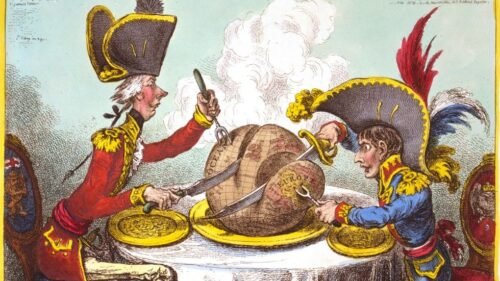As a name and a concept, Latin America was a creation of the court of the former French Emperor Napoleon III. It was a notion linked to France’s intent to conquer Mexico. A process that took place between 1861 and 1867.
On October 9, 1861, Napoleon III wrote to his Ambassador in London, Count Flahaut, that if Mexico could be regenerated under the influence of France, they would have erected an insurmountable barrier against the encroachments of the United States. On July 5, 1862, he wrote a letter to General Elie Frederic Forey, emphasizing that France had a historic mission to restore the strength and prestige of the Latin race that lived on the other side of the Atlantic.
Napoleon’s Pan-Latin project
The aims, barriers and Latin strength mentioned earlier represented two sides of the same coin. They laid the groundwork for Napoleon’s Pan-Latin project in the Americas. One aim was to counterbalance the rising Anglo-Protestant power by strengthening the influence of Latin Catholicism. A Latin power, of course, remained under the tutelage of France.
The nature of the Latin connection between France and the Hispanic part of the Americas stemmed from their shared Roman heritage, a heritage also shared by Brazil. However, although Brazil is considered a fundamental part of “Latin America,” it represented a completely different proposition in terms of France’s imperial ambitions. With an Emperor from the Royal House of Braganza ruling that country and Great Britain leading its international trade, Brazil was beyond the reach of Napoleon’s grandiose plans.
Such a common heritage dates back to ancient times. The original Latins inhabited central Italy in what is now the region of Lazio. Through conquests led by their dominant city-state, Rome, the rest of Italy became “Latinized.” In other words, the term Latin lost its specific ethnic meaning and gained a political and cultural one. As Roman power expanded to what would later become France, Spain and Portugal (among others), these regions also became Latin spaces. Roman law, traditions, architecture and the Latin language were imposed upon them.
Circa 313 AD, Roman Emperor Constantine decriminalized Christianity, promoting its rise, which would shortly thereafter become the official religion of the Roman Empire. Thus, this marks the origins of the Roman-Catholic Church.
Vulgar Latin, in its context, was the language spoken by ordinary citizens of the Roman Empire, distinct from the cultivated form of Classical Latin. It encompassed the vernacular dialects that later evolved into the so-called Romance languages. These include languages like Italian, French, Spanish or Portuguese.
The Pan-Latin thesis that emerged during Napoleon III’s reign aimed to highlight the shared traits between the “Latin Race” of the Americas and Europe. Both groups, on either side of the Atlantic, shared religion, culture and Romance languages. As a result, the Latins of the Americas were encouraged to become natural allies of Latin Europe in their cultural struggle not only against the Anglo-Saxon world but also against Teutonic and Slavic Europe.
Of course, Mexico was just the first step in Napoleon’s plan to establish other French satellite monarchies in the region. But how did Napoleon’s ambitions over Mexico materialize? To answer this, some background information is required.
How did Napoleon’s ambitions materialize?
Since its independence from Spain, Mexico’s Conservatives had always aspired to a monarchical system of government under a European prince of royal blood. Time and again, this idea tended to re-emerge among their most notorious representatives, particularly Lucas Alamán. This became more urgent for them after a weak Mexico faced the loss of half of its territory to a much stronger United States.
In the 1850s, however, the Liberals gained control of Mexico and began passing a series of reform laws aimed at reducing the power of the Church and the Army. This process culminated with the enactment of the 1857 Constitution, which triggered a military revolt by the increasingly marginalized Conservatives. It was known as the Reform War.
By December 1860, the Liberals had won this war, and in March 1861, Benito Juarez, who led this faction as Provisional President, was officially elected President of Mexico. The defeated Conservatives saw the possibility of a monarchical regime, under a European prince of royal blood, as the only remaining solution to their problems.
Thus, they proceeded to lobby (some of their members had been doing so since the beginning of the civil war) Emperor Napoleon III. Their objective was that a European prince, under his stewardship and with military support, would become the monarch of Mexico.
This proposal was music to Napoleon’s ears, who, after his country’s military success in Indochina, aimed to expand his empire. Not surprisingly, he wanted to follow in the footsteps of his famous uncle of the same name, who, at the beginning of the nineteenth century, had controlled Europe for a decade and a half.
Significantly, the gates of Mexico and Hispanic America had just opened to European infiltration. Indeed, in January 1861, seven southern states seceded from the United States, forming a new country called the Confederate States of America. The war between the two parties resulted in a sudden halt to the enforcement of the Monroe Doctrine. This doctrine, issued in 1823 by President James Monroe, formally warned European monarchies that the United States would not tolerate further colonization or the creation of tributary monarchies in the Americas.
Furthermore, Napoleon III believed that the South would win such a war, implying that Mexico’s northern neighbor would not be a strong United States, but a weakened Confederate States of America. A new country in need of France’s recognition and support. In other words, ambition and opportunity aligned perfectly. As a result, in 1861, France invaded Mexico.
Maximilian of Habsburg, brother of the Austrian Emperor Franz Joseph, was the designated French puppet to become the Emperor of Mexico. In Napoleon’s words:
The Prince who may mount the Mexican throne will always be forced to act in the interests of France, not only from gratitude but even more because his country’s interest will be in accordance with ours, and he will not be able to maintain himself without our influence.
After consolidating the conquest of most of the country by French troops and relegating President Benito Juarez to its fringes, the crown was offered to the Austrian prince on July 10, 1863. According to the Treaty of Miramar, signed between Maximilian and the French Empire, the future Mexican Empire was required to cover all military costs associated with the French invasion and presence in Mexico. Maximilian was finally enthroned in May 1864. However, it was to be a short-lived and tragic reign.
Surviving defeat
A combination of factors brought this adventure to an end. First, Napoleon III underestimated the stubborn resistance of the Mexican forces under Juarez. Second, choosing Maximilian was unsuitable, as his liberal ideas aligned more closely with those of Benito Juarez than with those of his Mexican Conservative allies. Third, the American Civil War ended with the Confederacy’s defeat on June 2, 1865, which not only re-established the Monroe Doctrine but also created conditions for war with the United States, which began sending surplus weapons and ammunition to Juarez’s troops. Fourth, France itself started to feel threatened by the rising power of Prussia under Bismarck’s capable leadership. The 40,000 French troops stationed in Mexico became increasingly needed in France.
On February 5, 1867, the last French troops left Mexico City. Although Maximilian was advised to withdraw with them, he chose to stay in Mexico, supported by the Mexican Conservatives. However, this poorly matched alliance could not withstand the growing strength of Juarez’s forces, now aided by American arms. On May 15 of that year, Emperor Maximilian was captured, and after a court-martial, he was executed on June 19. Two reasons motivated his execution: the atrocities committed by the French troops and a message to deter future invaders.
Maximilian’s patron, Napoleon III, would also suffer a crushing defeat three years later. Overwhelmed by the strength of the Prussian military in a war between the two countries, and captured at the battlefield of Sedan, Napoleon’s regime was overthrown by his own citizens on September 4, 1870.
Curiously, the term Latin America survived the defeats of the American Confederation, the Maximilian monarchy and the Napoleonic Empire itself. Furthermore, it was accepted as a sign of identity by the very people it was supposed to be imposed upon as an imperialistic project.
Given this final connotation, how can we explain the effortless adoption of the term by Hispanic and Portuguese (Iberian) Americans themselves?
How to explain the success of the term
An initial assumption might be that the Pan-Latin thesis is opposed to the US, especially since a few decades earlier, the United States had forcefully taken half of Mexico’s territory. However, that was not the case, as admiration for the US political system and entrepreneurial ingenuity remained high among Iberian American elites of that time.
The answer lay in rejecting Spain and everything Spanish, which was common among Hispanic American Liberals and the so-called Positivists who gained power in most of the region after them. Although both Liberals and Positivists rejected the French invasion, they rejected even more the heritage left by Spain, which they saw as a heavy burden on their efforts to modernize their countries.
The answer could also be found in the fascination that the Iberian American elites of the time felt towards French culture and civilization. Indeed, once the invading troops had been forced to withdraw in humiliation, there was no reason to reject the flattery of being considered the transatlantic cousins of the French.
As the well-known Mexican intellectual Carlos Fuentes remarked:
Where could we have looked at in search of models and inspiration? Nineteenth-century Latin America found its immediate answer in France and in the city that Baudelaire called ‘the capital of the XIX Century’. Parisian influence was felt everywhere from The Hague to Algiers, from St. Petersburg to Cairo. Nonetheless, in Mexico, Bogotá or Buenos Aires, it filled up the deep void left by Spain. Repudiating Spain meant accepting France as a new temple of freedom, good taste, romanticism, and all the good things that life had to offer.
Redeeming the Western credentials of the region while bypassing Spain was well-received by the elites of the day. Especially so, if the country they admired the most became their bridge to the Western world. It was thus that a notion born with imperialistic designs ended up being gladly accepted by those upon whom it was supposed to be imposed. Hence, the paradoxical nature of the notion of Latin America.
[The ideas expressed in this piece can also be found in Alfredo Toro Hardy’s book “Understanding Latin America: A Decoding Guide”]
[Kaitlyn Diana edited this piece]
The views expressed in this article are the author’s own and do not necessarily reflect Fair Observer’s editorial policy.
Support Fair Observer
We rely on your support for our independence, diversity and quality.
For more than 10 years, Fair Observer has been free, fair and independent. No billionaire owns us, no advertisers control us. We are a reader-supported nonprofit. Unlike many other publications, we keep our content free for readers regardless of where they live or whether they can afford to pay. We have no paywalls and no ads.
In the post-truth era of fake news, echo chambers and filter bubbles, we publish a plurality of perspectives from around the world. Anyone can publish with us, but everyone goes through a rigorous editorial process. So, you get fact-checked, well-reasoned content instead of noise.
We publish 3,000+ voices from 90+ countries. We also conduct education and training programs
on subjects ranging from digital media and journalism to writing and critical thinking. This
doesn’t come cheap. Servers, editors, trainers and web developers cost
money.
Please consider supporting us on a regular basis as a recurring donor or a
sustaining member.
Will you support FO’s journalism?
We rely on your support for our independence, diversity and quality.









Comment